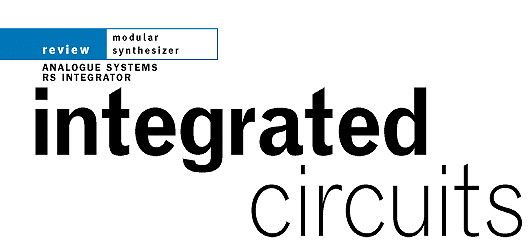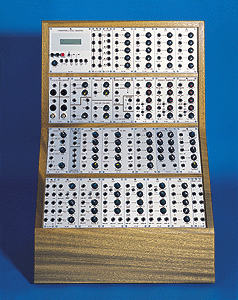Sound On
Sound Review Of The
RS200 (JAN 1999)
BACK TO SYSTEMS PAGE
|
Sound On
Sound Review Of The
RS200 (JAN 1999) |

ANALOGUE SYSTEMS RS200 ANALOGUE SEQUENCER
Analogue Systems have expanded
their RS Integrator modular range to include an analogue step sequencer and
several new modules - as well as a new, complete high-end system. Chris
Carter patches them in.

When I reviewed the Analogue Systems RS Integrator modular synth in SOS June 1998, I mentioned that further modules and systems were in development -- and six months down the line, up pop a new sequencer, a handful of new modules and a repackaged, more upmarket version of the RS Integrator itself, the System 8000.
As Easy As ABC
I'll come to the System 8000 in a minute, after I've described the RS200 Analogue Step Sequencer. This is a non-MIDI, 3-channel, 8-step sequencer, 72 HP units wide and designed to slot into the current standard Analogue Systems 19-inch case, while still leaving room for a couple of additional modules (more on this later). The RS200 design is based on the earlier Analogue Systems TH48 sequencer, a 3-channel, 16-step, self-contained free-standing unit (reviewed SOS April 1995).
As I mentioned, the RS200 has three channels, A, B and C, with individual controls for each of the eight steps and a stepped range knob for adjusting the overall output voltage of each channel (0V to +10V). Channel C also has a Slew control for smoothing the output voltage, or introducing a portamento effect if used with a VCO. In addition to a step indicator LED, each channel also has two toggle switches. One is a three-way Skip/Off/Reset switch which respectively skips selected events, does nothing, and resets the pattern back to the beginning at a specified step.
One Step At A Time
RS200
ANALOGUE SEQUENCER
£649
pros
![]()
Versatile
and relatively easy to use.
![]()
Some
unique features.
![]()
Excellent
build quality.
![]()
Available
as a stand-alone unit or module by module.
![]()
Reasonably
priced.
cons
![]()
Only
8 steps per channel.
![]()
Channels
can only be chained in series using the RS150 module.
![]()
No
control of gate output width.
![]()
Unusual
Trigger output configuration.
summary
A
versatile, well equipped, non-MIDI analogue sequencer.
It may lack some features of its earlier incarnation
(the TH48) but then again it includes a few unique
features of its own. A quality sequencer at an
acceptable price.
![]()
The other switch (Trig1/Off/Trig2) is a three-way trigger gate pulse output selector. Rather than the usual method of using a trigger output for each channel, there are instead two switchable trigger outputs (either trigger 1 or 2) for each step, and a third gate pulse that's activated at each step regardless of the trigger output switches. There is also a separate End Pulse output that triggers on the last step of a sequence. Not having three individual and simultaneous channel triggers could be thought of as restrictive, but switchable triggers do allow for some interesting rhythmic variations -- a case of swings and roundabouts, I suppose. The internal clock (LFO) has a range specified as 0.01Hz to 30Hz (though the model I tested seemed to range only from about one step every seven seconds to all eight steps in half a second or so) and can be voltage controlled. An external clock, LFO, VCO or 10V trigger source can also be used to drive the sequencer.
Skip A Dee Doo Dah
An unusual feature I haven't seen before on an analogue sequencer is the Skip In socket. This is described by Analogue Systems as an 'experimental socket', to be used in conjunction with the Skip/Off/Reset switches and, as I discovered, it allows some interesting if sometimes unpredictable results. For example, sending the output of the sequencer's internal clock to a frequency divider and putting all the switches to Skip, then feeding the divided signal into the Skip In socket causes a sequence to play, then pause at a step, play again then pause at the next step, and so on... Feeding a noise source into the Skip In, by contrast, introduces a random element into the playback speed, and I found that using a random sample and hold voltage can even cause the sequence to step backwards. Skip In is a very useful and unique feature, and I'm sure many users will find all kind of creative uses and abuses for it.
Lastly, a Step button allows you to shift the sequence along one step at a time, while the Start/Stop button and Start/Stop input socket allow you to trigger playback from the front panel or an external source.
Standing Alone
The RS200 sequencer is also available as a stand-alone package in an RS10 3U case and with two additional modules, the RS150 Sequential Switcher and the RS260 Voltage Quantiser. The RS150 is a basic 4-into-1 pulse- (or clock-) driven sequential switcher. Each of the inputs can accept audio or control voltage signals, which can be selected sequentially using a control signal fed into the Clock Input socket, or by flicking the Stop/Step toggle switch. Another toggle switch sets the number of active inputs (2, 3 or 4) which then appear at the switcher output socket one after another.
Free Run
The RS260 module is a single-channel quantiser with a range of approximately five octaves. It responds to changes at either of the two V-In sockets, and at each detected voltage change transmits a new quantised voltage (0-5V) and a separate gate pulse (+10V). The controls are kept to a minimum, with just an output Offset knob for tuning and a Free Run/Ext Gate toggle switch. With the switch set to Gate In, the quantiser shifts to a new output voltage only if a separate gate/trigger is detected. If it's set to Free Run mode, the quantiser shifts to a new quantised output only if it detects a change in voltage at either of the CV inputs. Having two mixable CV inputs gives rise to some unusual glissando effects if, for instance, two waveforms such as a triangle or sawtooth waves are used at different speeds. A third CV input is also available, the Trans In socket. Connecting a CV keyboard output to this socket allows you to transpose the quantised output over a five-octave scale, a useful feature if the module is being used to quantise the output of the analogue sequencer. The Quantiser is an indispensable module with or without the sequencer, but its main use is faster and more accurate setting up of the unquantised sequencer outputs.
The RS150 Sequential Switcher is also a versatile module in its own right (almost a mini sequencer), but when used with the RS200 it definitely makes the sum greater than the parts. One feature lacking in the RS200 is the ability to run the channels in series, to get 16- or 24-step sequences. However, by sending each of the three sequencer channels into three of the RS150 switcher inputs, you can use the sequencer End Pulse output to step the switcher clock through the sequencer channels, giving you 8-, 16- or 24-step sequences at the flick of a switch.
Smart Choice
It's a shame that, unlike its earlier TH48 incarnation, the RS200 is only an 8-step sequencer, and that it's CV outputs are unquantised; I also missed not having a variable gate time control, although you could use the RS50 Trigger Shaper module for that purpose.
As with most analogue sequencers, however, using the RS200 is a doddle, and although adding the additional modules makes programming a little more complex you do have a seriously versatile unit. The basic RS200 module is very good value and the build quality is particularly high. Even though the stand-alone package with sequencer, quantiser, switcher, case and all costs substantially more, I still think it's still a fairly reasonable price for such pro piece of analogue kit. If you are a user of Analogue Systems modular synths (or Doepfer modules) and you don't yet have an analogue sequencer the RS200 is going to be a very smart choice.
|
Sound On
Sound Review Of The
RS200 (JAN 1999) |